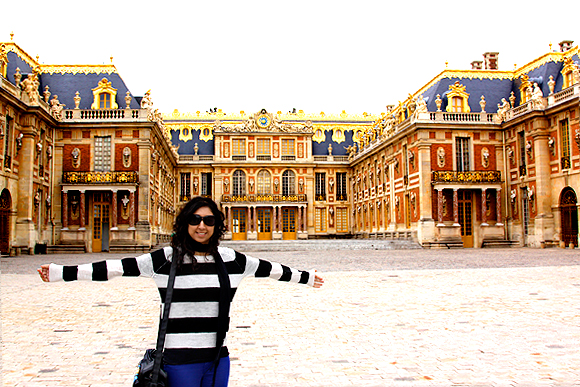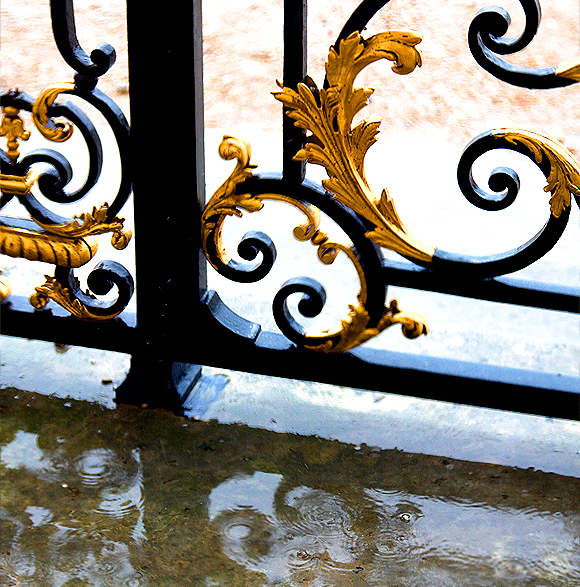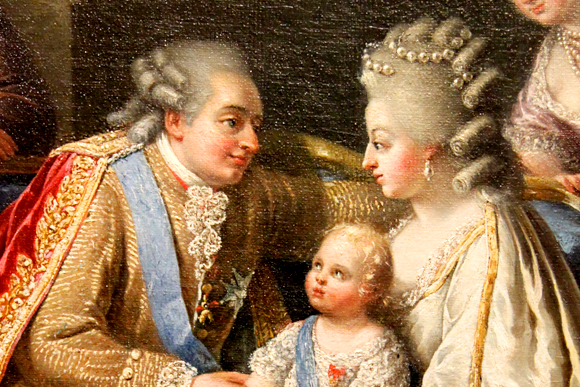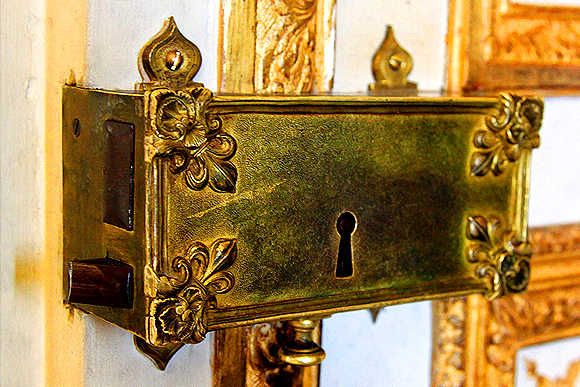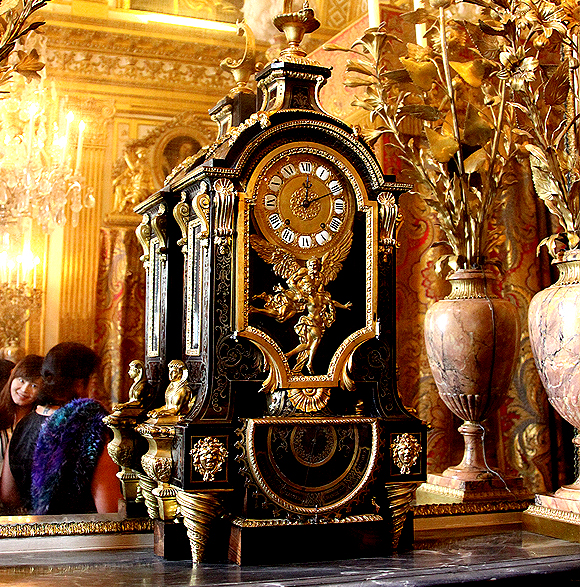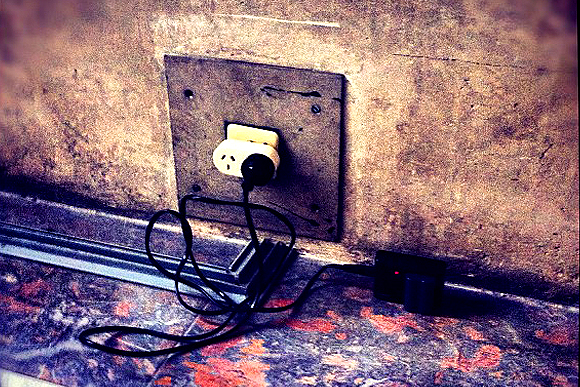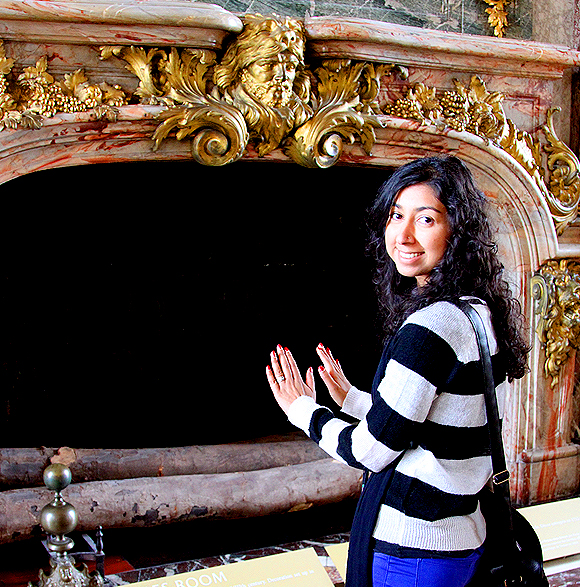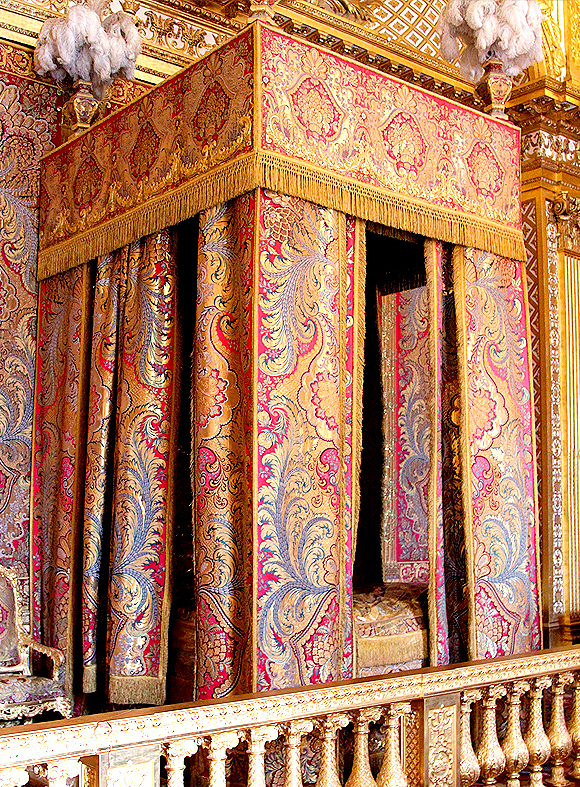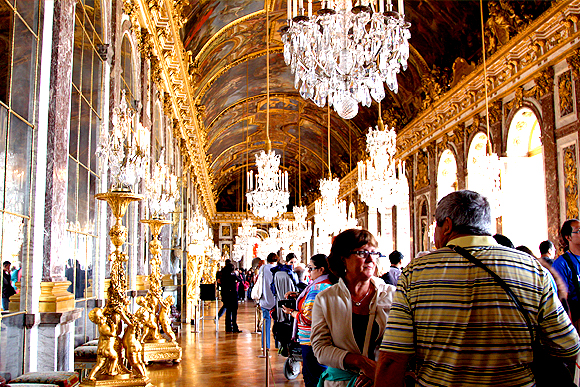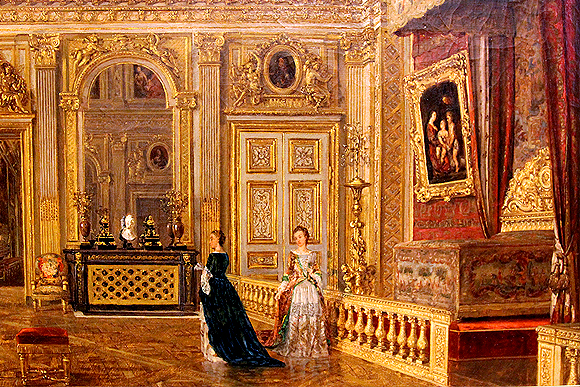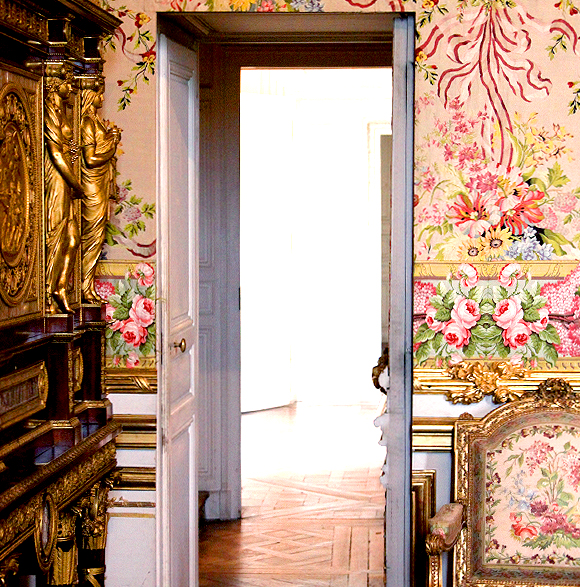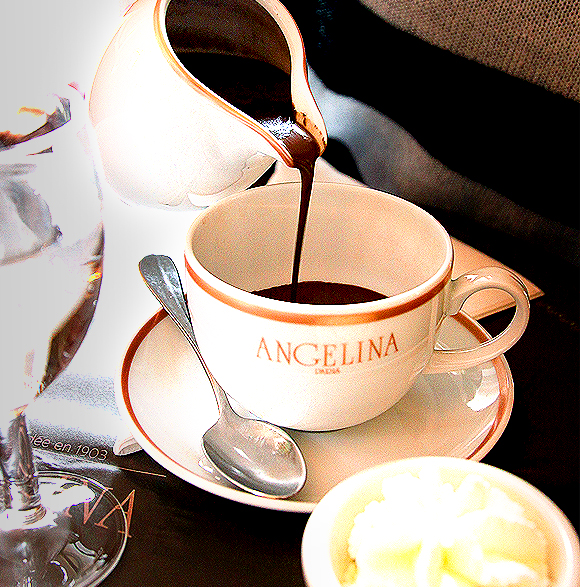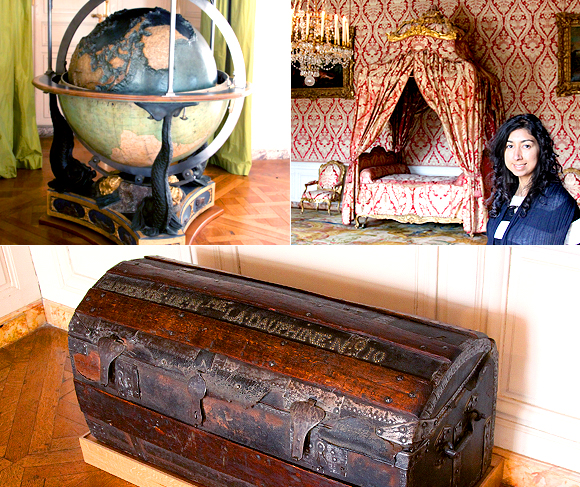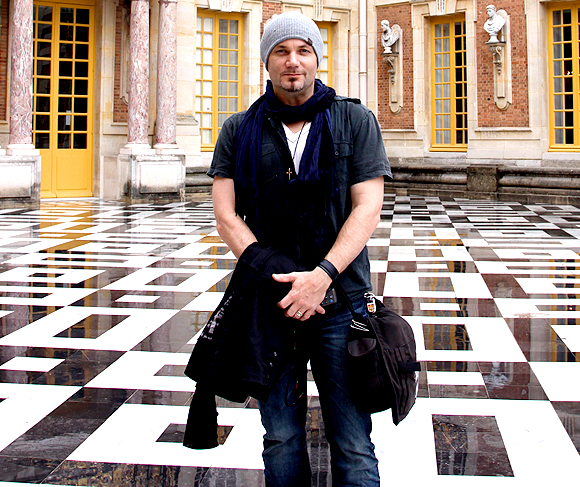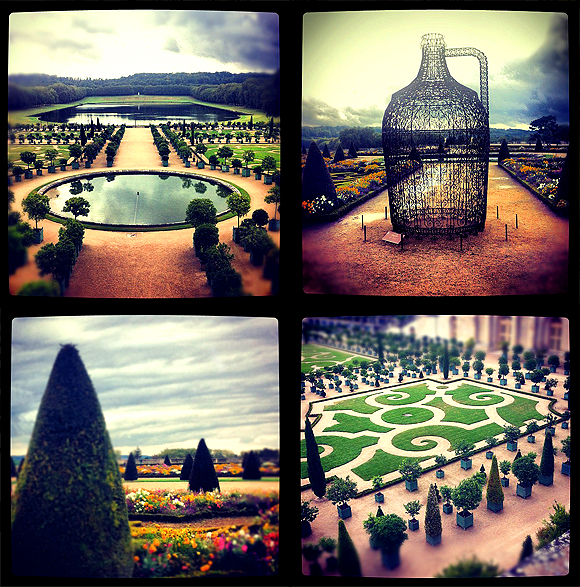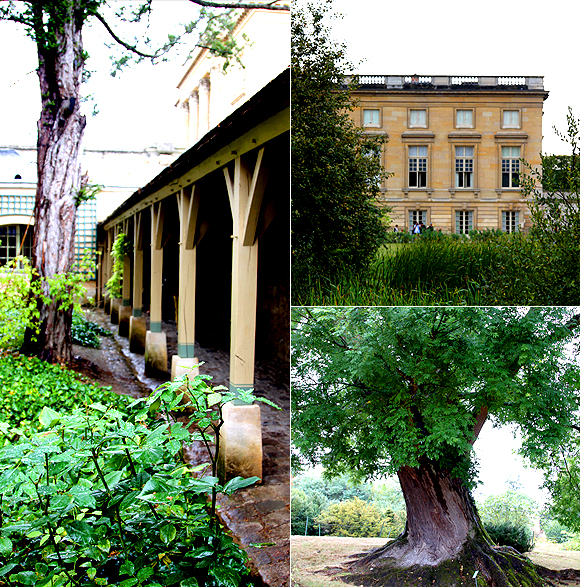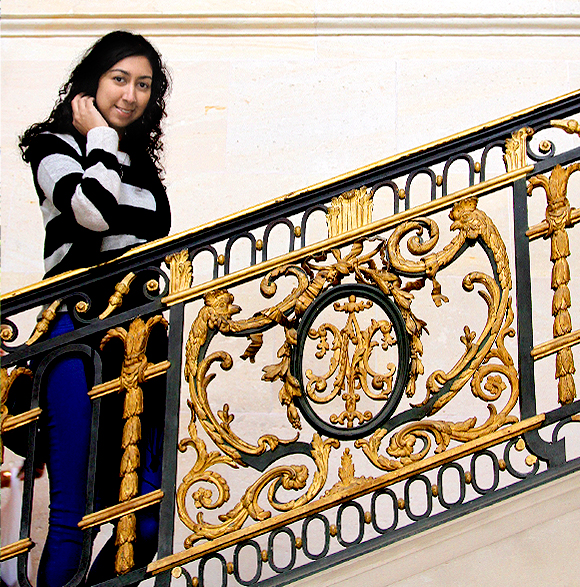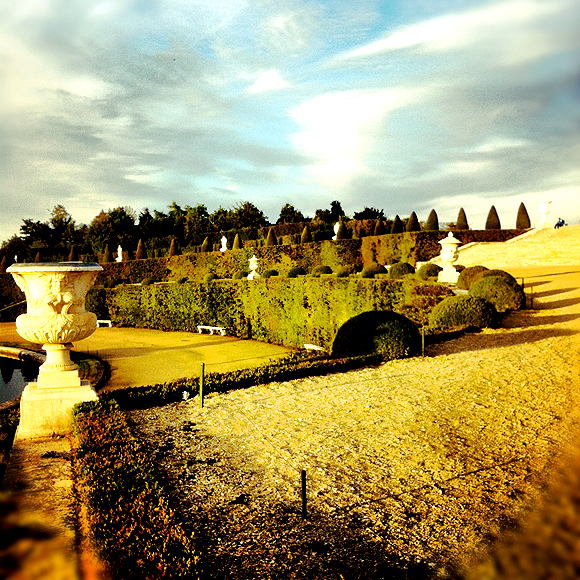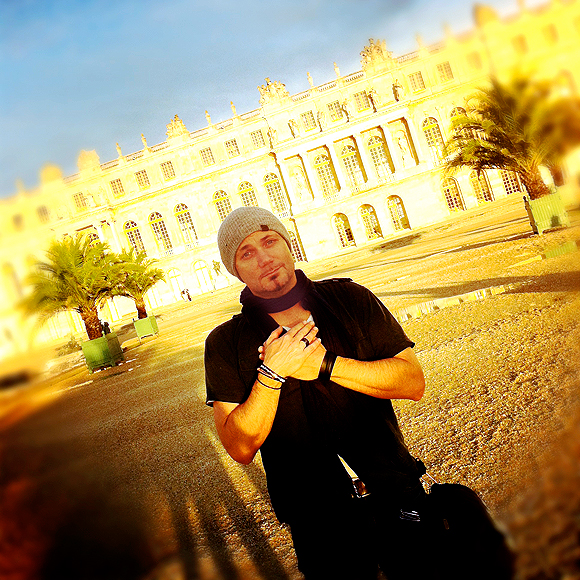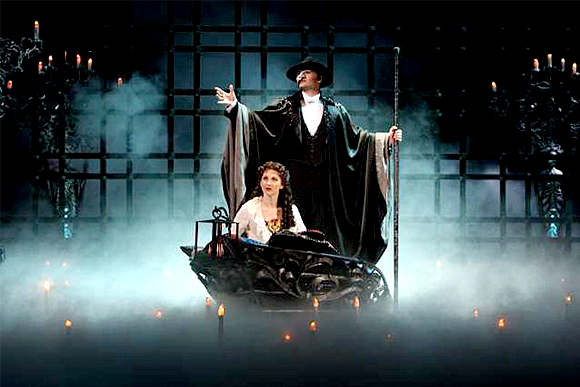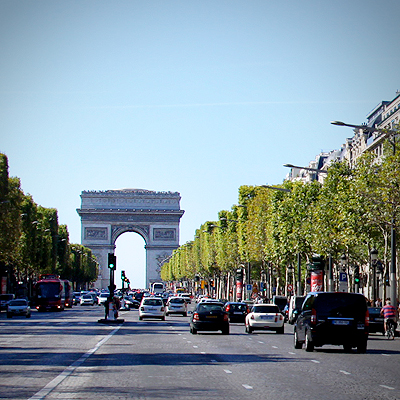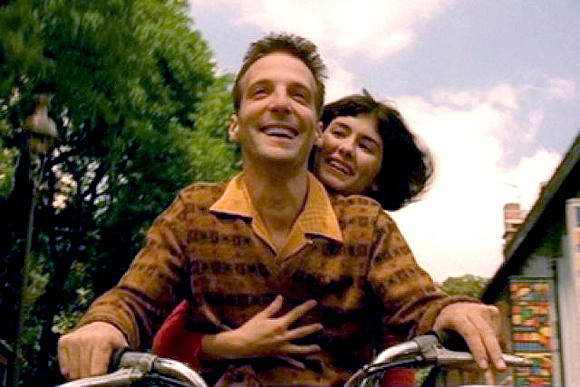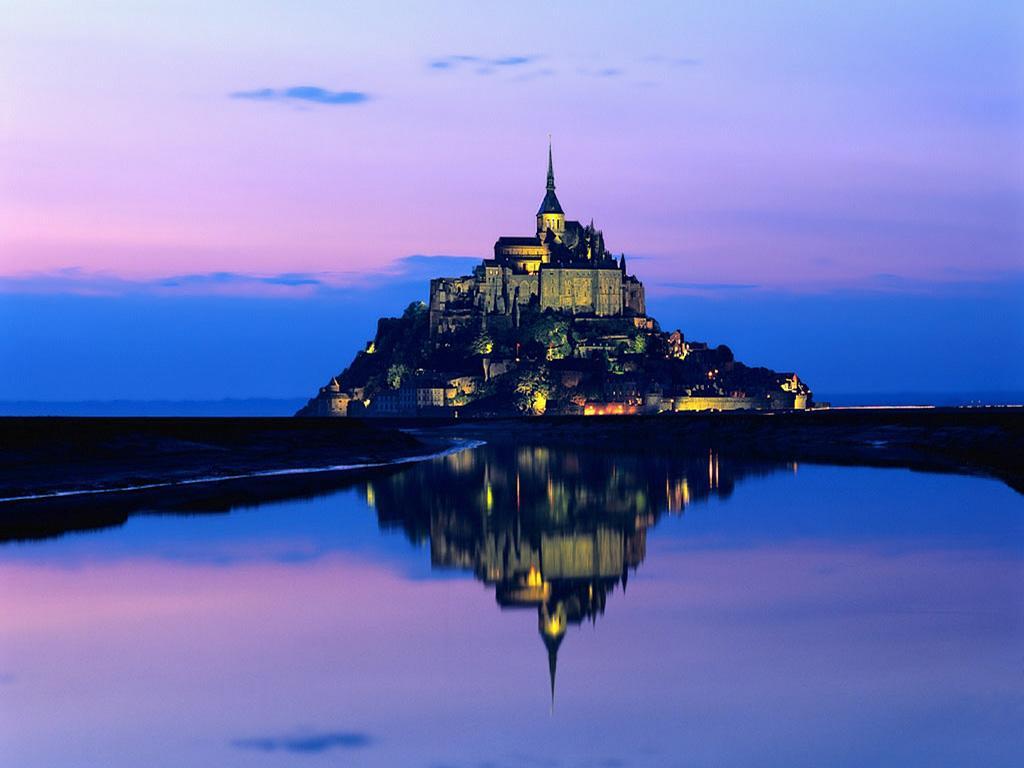The Château de Versailles is a name that brings to my mind both the pinnacle, and the demise of the French monarchy. It is simultaneously the most glorious of all palaces, golden and gargantuan as the centerpiece of the town of Versailles… as well as the most shameless; the most decadent and indulgent trophy home of it’s time.
We visit on a cold, wet and grey Autumn day (not too dissimilar from today in fact). Funny – the way I always end up at this palace in the rain… still, it sets the mood, as the stormclouds gather above, casting a rather fitting, grim shadow over the dark history of Versailles.
While it is a sight not to be missed when visiting France, the buildings that comprise the Château de Versailles and their surrounding grounds require serious planning if you intend to cover it all in a single day. The palace alone spans 67,000m2, before you even get to the gardens – which more than doubles the distance you have to cover. So believe me when I say you’ll need every minute of daylight afforded to you, and you’ll need to use it wisely.
The following are 9 simple suggestions for an itinerary which I hope will help make your visit an efficient and memorable one.
1) Don’t take an organised bus tour – do take a packed lunch!
2) Start early.
3) Visit the Grand Apartments first (90 minutes).
4) Take a morning tea break at the Angelina cafe (30 minutes).
5) Visit the Apartments of the Dauphin and the Dauphine (60 minutes).
6) Explore the gardens (60 minutes).
7) The best fries in France (30 minutes).
8) Dedicate half the day for the Trianons and Hamlet (4 hours).
9) Stay until closing to see the sunset over the palace.
1) Don’t take an organised bus tour – do take a packed lunch!
Unless you enjoy sitting with a bus load full of elderly tourists and having your day dictated to you over speakerphone, I suggest you find your own way there.
You can buy your tickets in advance on the official Versailles website. Then, take the 7:57am RER C train from Saint-Michel Notre Dame to Versailles Rive Gauche. (Check the official SNCF website for the full, current timetable.)
You’ll arrive at 8:35am, which gives you just enough time to find your bearings, walk to the Palace, and start lining up. The map below will help you find your way to the Palace from the train station – it’s quite impossible to get lost!
View Versailles by Train in a larger map
I’d also suggest to take a baguette for lunch and plenty of water. You can buy snacks at Versailles, but lunching can be an expensive affair!
2) Start early.
The tour buses will begin to arrive between 9:00am and 9:45am. You want to make sure you’re first in line outside the Palace, so there’s a minimal queue for the audioguides inside (unlike the ones at the Louvre, these are definately worthwhile!), and you’re able to take photographs without a hundred people photo-bombing your holiday memories.
To give you an idea of what I’m talking about, this is what the palace looks like on a good day:
So believe me when I say, get there early! The photo above was taken in the Grand Apartments, outside the Hall of Mirrors. We had to stop a moment to take in the tidal wave of people and their tour guides. Heed my words and don’t get caught in the current or you’ll be swept away before you’ve had a chance to see anything at all.
3) Visit the Grand Apartments first.
Home to King Louis XVI and Queen Marie Antoinette, the Apartments on the first floor of the Palace are split into two; the Kings Apartments, and the Queens Apartments.
The rooms were sacked and looted during the revolt of the people at the fall of the monarchy, but great attention has been put into finding and restoring the items that were lost, or replacing them with close substitutes. To the humble onlooker, it is an entirely authentic experience.
Myself, I like to imagine that these very seats once cushioned royal bums;
That the old locks once had keys which are long lost in history;
And that this antique clock stood formidably through time and delivered minute after minute to four generations of French Kings.
On the other hand, I’m not so sure about the powerpoints being original 18th Century construction, but they do prove useful when our camera runs out of charge. We rest our common bottoms on the plush seats and hope no-one notices the flashing red light on our camera charger…;
One of our favourite rooms in the Apartments is the Salon d’ Hercule, the first room of the King’s. The magnificent marble fireplace was carved from a single piece of stone – but I wonder if a hearth even so immense could warm up a room of this size.
Although not the largest in the Palace, the Salon d’ Hercule served as a ballroom during the reign of King Louis XV. This impressive space is made even more striking by the painting “Apotheosis of Hercules” mimicking the sky across the ceiling, and the famed artwork “Feast in the House of Simon” spanning the great length of the far wall, opposite the fireplace.
Venturing further into the Apartments we enter the King’s Bedchamber. There is something macabre about the room; whether it’s the ghost of the Sun King lying gangrene-ridden on his bed, his last exhale mingling with the air we are now breathing, or if it’s knowing that his grandson (King Louis XVI) burnt the brocades around the bed’s alcove for the 60kgs of gold that was embroidered into it. (The hangings have since been restored in a fashion true to the period, in a project undertaken by the Fifth Republic.)
The windows that once opened onto the terrace from the chamber are now gone, and the terrace has since been transformed into The Hall of Mirrors (circa 1678) – the famous gallery that connects the King’s and Queen’s Apartments. It is lined with mirrors, and in combination with a roof dangling with chandeliers, it makes for a sparkling reception. It is by far the most popular room of the whole Palace, and we struggle to take a decent photo with the flood of people around us.
My video attempt at least gets the whole room in, albeit very amateur!:
Entering the Queen’s Apartments, I am struck by the familiarity of the Bedchamber. The grand, draped bed and balustrade featured in the recent movie, Marie Antoinette, makes me feel like I’m entering a movie set. But the stars that walked these floors were long dead before Hollywood shone it’s lights for the first time.
The room has been redecorated and renovated twice in it’s history. The first time by King Louis XV and Queen Marie Leszczynska, who in addition to refreshing the decor, built in a secret passageway that lead to the King’s Apartments; the second time by Queen Marie Antoinette, again redecorating to bring the furnishings in line with current fashions.
The bed that birthed 19 royal children – and home to three Queens – sits squarely center beyond the golden divider. It was tradition during those times that an audience from the court would attend the birth of royal children. However Marie Antoinette was the first Queen to birth her children in privacy (you’ll read later how important privacy was to her). During her first birthing, she began to hemorrhage and passed out (partly due to the stifling atmosphere of having such a large audience, and partly due to the doctor accidentally injuring her). Legend has it King Louis himself wrested the windows from the wall, and broke them open to revive her. Following that incident, audiences were denied entry into her rooms during the birth of her latter children.
In addition to birthings, Marie Antoinette would take an audience for her daily toilette (dressing) session in this room every morning, during which members of court watched her attendants bathe her (in a bath that was rolled into the room), dress her, and do her hair.
She would also, one dark night in October 1789, escape through the (aforementioned) secret door and passageway next to her jewellery cabinet, fleeing the birth of the Revolution as the marauding public took Versailles as their own.
Unfortunately the Queen did not live long, despite her lucky escape from Versailles. Following the beheading of her husband, she was put under trial in Paris and found guilty of treason; facilitating orgies in the Palace, bankrupting France to aid Austria (her homeland), and incest with her son – all false accusations that ultimately lead to her deep depression, ill health, and her own beheading on the 16th October, 1793.
4) Take a morning tea break at the Angelina cafe
I can only assume the presence of Angelina (founded by the Austrian confectioner Antoine Rumpelmayer) as the resident cafe at Versailles is in tribute to the Austrian-born Archduchess Maria Antonia – otherwise known as Queen Marie Antoinette – who breakfasted on either coffee or chocolate every morning.
The cafe’s Parisian location was a favourite of Coco Chanel’s – and it’s no wonder considering the lush, hot fountain of chocolate that is served with a dollop of whipped cream. Just the pick-me-up that weary feet need after a couple of hours of shoulder-to-shoulder combat in the Grand Apartments…
Stopping in for morning tea will mean you avoid the lunchtime rush. We were seated within minutes, only to look out and see a pile of tourists shuffle into the foyer, forming a queue that turned the corner and beyond. And if you’re on a budget like we were, a small snack instead of a big lunch will save you precious Euro. Boutique French cafe = boutique french prices!
5) Visit the Apartments of the Dauphin and the Dauphine.
The little Prince (Dauphin) and Princess (Dauphine) were given the lower floor of the Palace as their living quarters. I found these rooms much more pleasant than the Grand Apartments, for two reasons; the lack of other people in my personal space (thank you, lunch hour!), and the lack of gaudy decor.
These rooms are significantly less gilded – and peering down the corridor which links the individual Apartments, you can see a succession of rainbow walls; the first room plastered in red, the next blue, the following one yellow. We felt less rushed down here, and enjoyed the audio guide at our leisure, not missing the claustrophobia experienced in the Grand Apartments at all.
In the above photos you will see the Bedchambers of both the Dauphin and the Dauphine, the library, trunk, and other paraphernalia that once belonged to Princess Marie-Therese Charlotte and Prince Louis Joseph.
6) Explore the gardens
Exiting the palace via the exquisite black-and-white marble courtyard will lead you to the Jardins du château de Versailles.
There is no easy way to visit the extent of the gardens – you’ll have to choose your attractions wisely, now only having half a day left to explore the majority of the palace grounds. This map of the Versailles gardens will help you plan your afternoon.
We start our journey in the South Parterre and Orangerie, styled in the formal “French Garden” fashion.
I wonder if the royal children played hide-and-seek between the hedges of the pristine gardens, tiny cherubs in white lace running circles around their mother.
We meet a few cherubs of our own on our walk through the groves – half a dozen kittens appearing at random, bleeding in and out of the maze-like hedging, like ghosts in the walls. They are shy and play coy for a while, before pouncing on our offerings of crumbs and posing for photos like old friends.
The groves were our favourite squares of the patch-worked gardens; secret pockets that surprised and delighted at every corner. At the center of each one was a fountain or statue that made traipsing through the wet all the more worthwhile.
Not that the rain was going to stop us. We made our own fun, despite the weather:
Unless you’re a fast walker, hiring a buggy or bicycle to explore the gardens and fountains is a good option, however it is expensive, and there is a time limit on how long you can keep the vehicles for (one hour in my experience). I’d suggest you make use of one of these facilities for the gardens only, and opt for the petit train or your own feet to make your way to the Trianons.
7) The best fries in France
Yes, you read right. The best fries in France are served at the parkside bistro, La Flottille, just next to the Grand Canal.
We may have been biased after a long day of walking in the cold, but the taste of those hot, salty, slender french fries was good enough to win us over… let alone the added bonus of having Tabasco available to us. Condiment heaven!
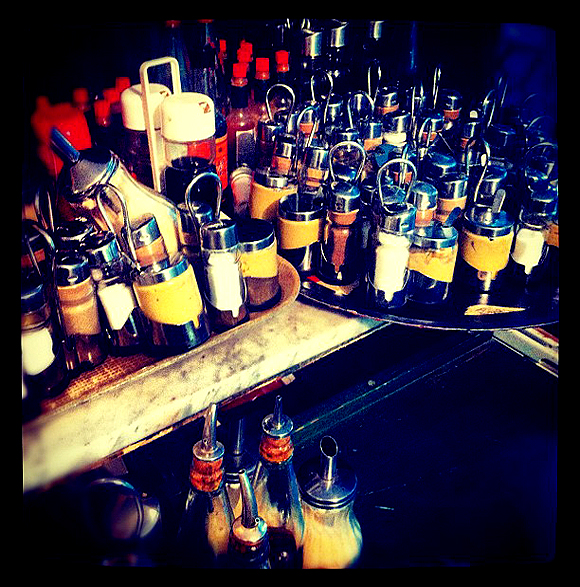
8) Dedicate half the day for the Trianons and Hamlet
Sadly, we only left ourselves one hour for this part of Versailles, but I urge you to learn from our mistakes, and prioritise these over the Grand Apartments!
The Grand Trianon and Petit Trianon are smaller chateaux built on the outskirts of the palace grounds. But don’t let the term “smaller” fool you – the Grand Trianon, or King’s estate, is a palace in itself, and has it’s own grounds, gardens and amphitheatre. We were running low on daylight, so decided to skip the Grand Trianon and make a mad dash for the Petit Trianon, the Queen’s estate.
Originally built for King Louis XV’s mistress (who didn’t live to see it’s completion), Marie Antoinette was gifted the Petit Trianon by her husband as her retreat away from court. She loved her privacy, and allowed no-one in without permission – even her husband! Walking into the front courtyard, already softened by the lush ferns of an interior garden, you can see why – and feel the drastic change in ambiance immediately. The lack of state formalities and social obligations fall away, all that is left is the intimate atmosphere of a family home, buried in the green countryside.
The building was designed to seem self-sufficient, without the need for servants. The kitchen was located in an outbuilding, a distance away from the Trianon, and only a “warming room” to heat the plates for dinner service was provided internally. Mechanical gears were put in place to lower and raise the dinner table through the floor so that again, the service was invisible. (This was never completed, but the levers and cogs are still there…)
Whilst already ahead of it’s time, Marie Antoinette undertook an additional renovation of the chateaux – including changing the monogram on the great staircase from King Louis XV’s to her own:
She also took a great interest in horticulture, and had the northern gardens redone in English fashion, complete with it’s own “Temple of Love”. The ornate and intricately-carved marble structure once housed a statue of Cupid cutting his bow from the Club of Hercules, but now a replica stands in its place (the original is kept safe in the Louvre).
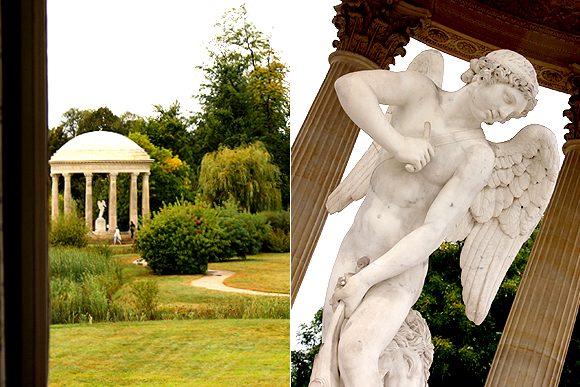
The Corinthian-inspired “Temple of Love” in the English gardens of Marie Antoinette’s estate. Original statue by Deschamps Replica by Mouchy.
Our one regret is not being able to see the Queen’s Hamlet – a farm and village with an exquisite picture-book feel created by Marie Antoinette as another countryside retreat for herself and her ladies. Liz from Young Adventures has some amazing photos from the Hamlet that make me want to start planning my next visit to Versailles!
The petit train runs frequently between the main palace, Grand Canal, Grand Trianon and Petit Trianon. It’s a 50-minute round trip, so not our first choice when it comes to reliable and speedy transfers throughout the grounds, but at only AU$10 for a hop-on-hop-off service, it is a decent backup plan in case you have a case of the tireds. The wait is usually a maximum of twenty minutes in peak season, but check the website for a more current timetable.
9) Stay until closing to see the sunset over the palace.
Maybe it was the sun finally showing it’s cheeky grin from behind those grim stormclouds, but sunset over Versailles was the most stunning lightshow I’ve seen. Warm beams of sudden sunlight danced on the puddles of rain, leftover from the daytime deluge. Shadows grew behind the gardens and statues were haloed in the setting light.
We took one last, long look around the expansive estate of Versailles, and then meandered back along the garden path, through the great gates, and down the cobblestones… glancing over our shoulders now and again for “one more” quick peek. It is a magical place steeped in history and rich in culture. We will be back.
I suggest you take a leisurely stroll back the way you came, through the front entrance (instead of the many side exits in the complex) and look back at the sunset over the statue of King Louis XIV at the front of palace. It’s a stunning sight, one not to be missed! You’ll now only be a short walk back to the station, and the trains come frequently enough that you’ll be home in time for dinner.
I hope the above tips and insights help you along your way. Do you have any Versailles secrets to share?
 Enjoyed this post? Read the next post from this series: “A Honeymooner’s Guide to six weeks in Europe” now!
Enjoyed this post? Read the next post from this series: “A Honeymooner’s Guide to six weeks in Europe” now!


